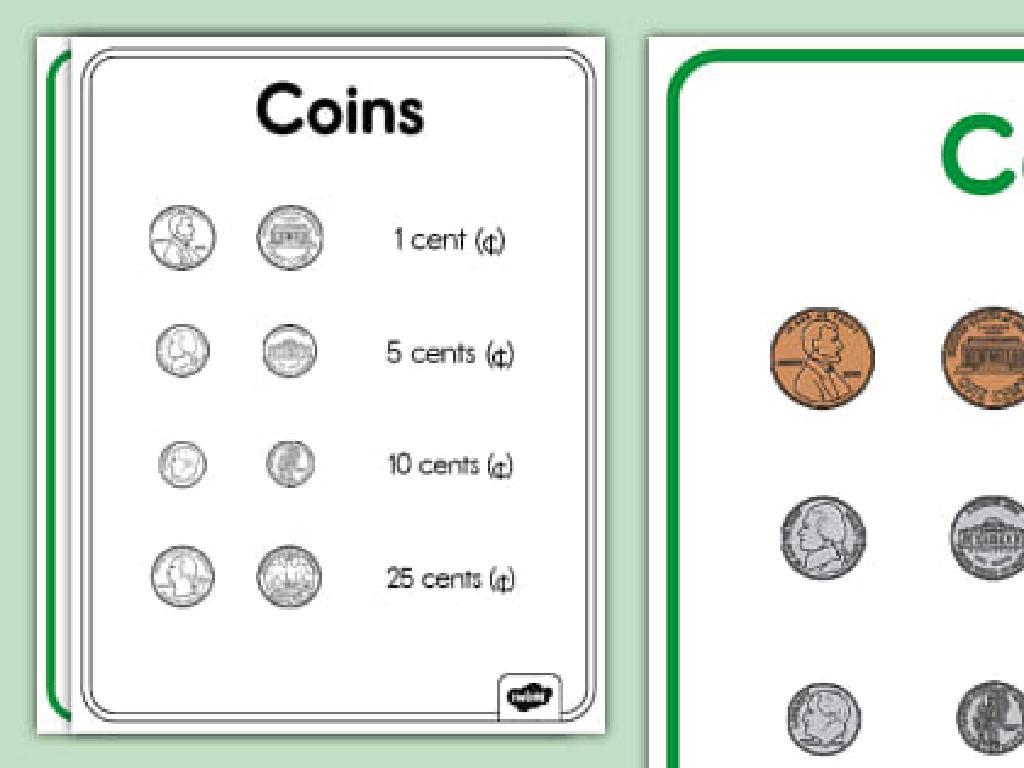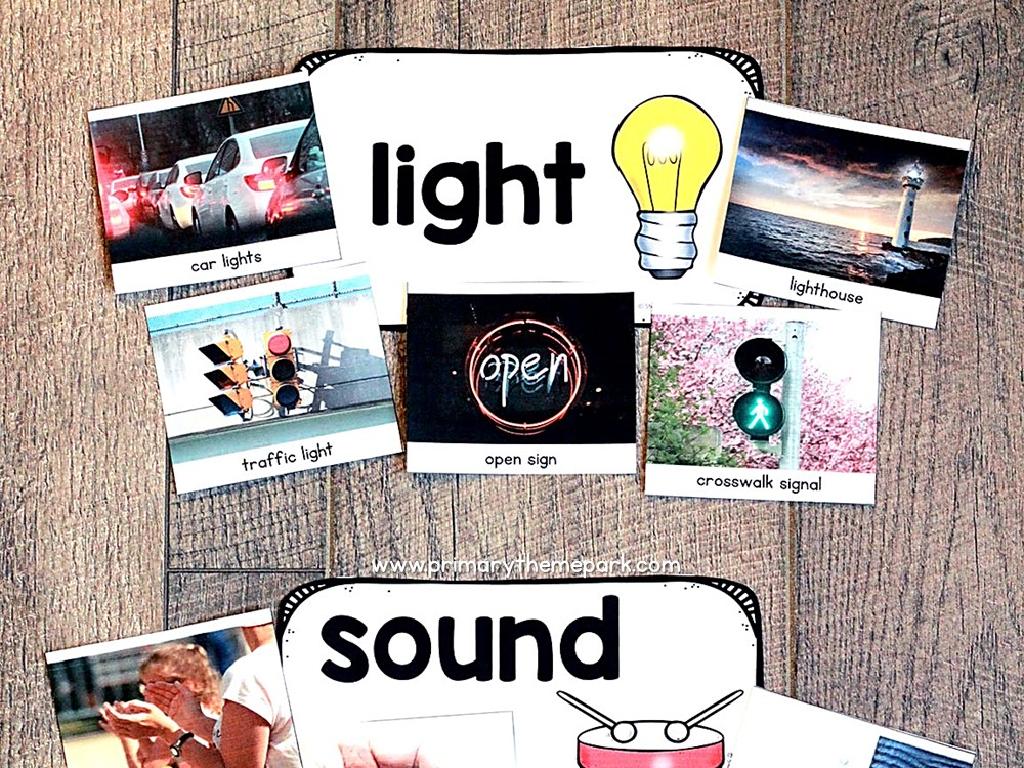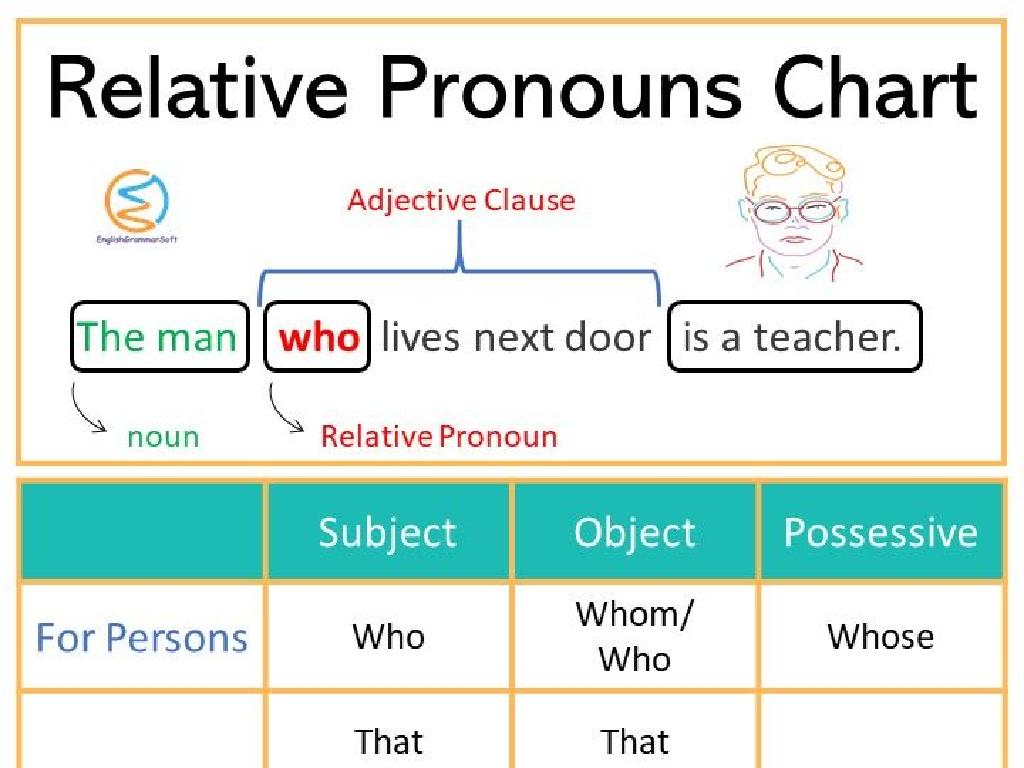Use Reflexive Pronouns
Subject: Language arts
Grade: Seventh grade
Topic: Pronoun Types
Please LOG IN to download the presentation. Access is available to registered users only.
View More Content
Diving into Reflexive Pronouns
– Recap: What are pronouns?
– Reflexive pronouns: The basics
– Pronouns that refer back to the subject, like ‘myself’ or ‘ourselves’.
– How reflexive pronouns are used
– Used when the subject and object are the same entity.
– Examples of reflexive pronouns in sentences
– ‘I taught myself to play guitar.’ or ‘They bought themselves a gift.’
|
Begin with a brief review of pronouns to ensure students recall their function in replacing nouns. Then, introduce reflexive pronouns, emphasizing that they are used when the subject of the sentence is also the object. Explain that reflexive pronouns always end in ‘-self’ or ‘-selves’ and correspond to the subject pronouns (I/myself, you/yourself, etc.). Provide clear examples to illustrate their use in sentences. Encourage students to create their own sentences using reflexive pronouns to reinforce their understanding. This will prepare them for more complex sentence structures and enhance their writing skills.
Understanding Reflexive Pronouns
– Define reflexive pronouns
– Pronouns that refer back to the subject
– Examples: myself, yourself, etc.
– ‘I did the homework myself’, ‘She prepared herself’
– Usage in sentences
– Emphasize the action the subject performs
– Differentiating from other pronouns
– Not to be confused with personal or possessive pronouns
|
Reflexive pronouns are used when the subject and the object of a sentence are the same, and they serve to emphasize the action performed by the subject. In this slide, we define reflexive pronouns and provide common examples that students will encounter. It’s crucial to show how these pronouns function within sentences to clarify their use. Additionally, make sure to highlight the difference between reflexive pronouns and other types of pronouns, such as personal or possessive pronouns, to avoid confusion. Encourage students to create sentences using reflexive pronouns to reinforce their understanding.
Reflexive Pronouns in Action
– Understanding Reflexive Pronouns
– Pronouns that refer back to the subject, e.g., ‘myself’, ‘yourself’.
– When to Use Reflexive Pronouns
– Use them when the subject and object are the same person.
– Matching Pronouns to Subjects
– Ensure the pronoun matches the subject in number and gender.
– Practice with Reflexive Pronouns
– We’ll do exercises to reinforce these concepts.
|
This slide aims to teach students about reflexive pronouns, which are used when the subject of the sentence is also the object. Begin by explaining the concept with clear definitions and examples. Emphasize the importance of matching the reflexive pronoun to the subject in both number (singular or plural) and gender. Provide examples like ‘I taught myself to play the guitar’ to illustrate proper usage. Encourage students to create sentences using reflexive pronouns that relate to their own experiences. As a class activity, have students work on exercises where they match subjects with the correct reflexive pronouns and create sentences using them. This will help solidify their understanding and application of reflexive pronouns in language.
Differentiating Reflexive and Intensive Pronouns
– Reflexive pronouns explained
– Pronouns that refer back to the subject, e.g., ‘I taught myself.’
– Intensive pronouns explained
– Emphasize the subject without changing the meaning, e.g., ‘I myself wrote this.’
– Examples of reflexive pronouns
– ‘She made herself a sandwich.’
– Examples of intensive pronouns
– ‘The CEO himself presented the award.’
|
This slide aims to clarify the difference between reflexive and intensive pronouns, which often confuse students. Reflexive pronouns are used when the subject and the object of the sentence are the same, and they are necessary for the sentence to make sense. Intensive pronouns, on the other hand, are used to emphasize the subject and are not essential to the sentence’s meaning; the sentence would still make sense without them. Provide clear examples for each to illustrate their use in sentences. Encourage students to create their own sentences using both types of pronouns to solidify their understanding.
Let’s Practice Reflexive Pronouns!
– Understand reflexive pronouns
– Interactive sentence practice
– Engage with sentences using reflexive pronouns
– Fill in the blanks correctly
– Use ‘myself’, ‘yourself’, ‘herself’, etc.
– Share and discuss answers
– Discuss why certain pronouns fit
|
This slide is for an interactive class activity focused on reflexive pronouns. Students will practice by filling in the blanks in sentences with appropriate reflexive pronouns such as ‘myself’, ‘yourself’, ‘himself’, ‘herself’, ‘itself’, ‘ourselves’, ‘yourselves’, or ‘themselves’. Provide sentences with missing reflexive pronouns and ask students to complete them. For example, ‘I made this cake ___.’ Students should fill in with ‘myself’ to complete the sentence. After the activity, encourage students to share their answers and discuss why they chose specific pronouns. This will help reinforce their understanding of how reflexive pronouns function within sentences. As a teacher, be prepared to explain common mistakes and clarify any confusion. Offer praise for correct usage and gentle corrections as needed.
Group Activity: Crafting Stories with Reflexive Pronouns
– Form small groups for story creation
– Include reflexive pronouns in your story
– Use ‘myself’, ‘yourself’, ‘herself’, etc.
– Each group will present their story
– Reflect on the use of reflexive pronouns
– Discuss how reflexive pronouns change the sentence
|
This group activity is designed to reinforce the students’ understanding of reflexive pronouns by integrating them into a creative task. Divide the class into small groups and instruct them to write a short story that includes reflexive pronouns such as ‘myself’, ‘yourself’, ‘himself’, ‘herself’, ‘itself’, ‘ourselves’, ‘yourselves’, and ‘themselves’. Each group will then present their story to the class, providing an opportunity for public speaking and peer learning. After the presentations, lead a discussion on how the reflexive pronouns were used and how they affect the meaning of the sentences. This will help students to internalize the concept and recognize reflexive pronouns in other contexts. Provide guidance and examples if necessary, and encourage creativity and collaboration among students.
Review and Reflect: Reflexive Pronouns
– Recap on reflexive pronouns
– Pronouns that refer back to the subject, e.g., ‘myself’, ‘yourself’
– Examples of reflexive pronouns
– ‘I did the homework myself’, ‘She prepared herself for the exam’
– Interactive Q&A session
– Clarify doubts about usage
|
This slide aims to consolidate the students’ understanding of reflexive pronouns. Begin with a brief review of what reflexive pronouns are and their function in a sentence. Provide clear examples to illustrate their use. Follow up with an interactive Q&A session to address any uncertainties the students may have. Encourage them to ask questions about reflexive pronouns in different contexts and provide additional examples if needed to ensure a thorough understanding. The goal is to ensure that by the end of the session, students can confidently identify and use reflexive pronouns in their writing and speech.
Class Activity: Reflexive Pronoun Hunt
– Find reflexive pronouns in books/songs
– Note the sentences they are used in
– Look for ‘myself’, ‘yourself’, ‘herself’, etc.
– Understand how they function
– See how they refer back to the subject
– Share examples with the class
|
This activity is designed to help students identify and understand the use of reflexive pronouns in a practical context. By searching for reflexive pronouns in materials they are already familiar with, such as their favorite books or songs, students will learn how these pronouns function to reflect back to the subject of the sentence. Encourage students to write down the entire sentence to see the pronoun in context. During the sharing session, discuss why the reflexive pronoun was used and what it adds to the sentence. This will help students grasp the concept more concretely. Possible variations of the activity could include creating their own sentences using reflexive pronouns or identifying reflexive pronouns in a provided paragraph.






